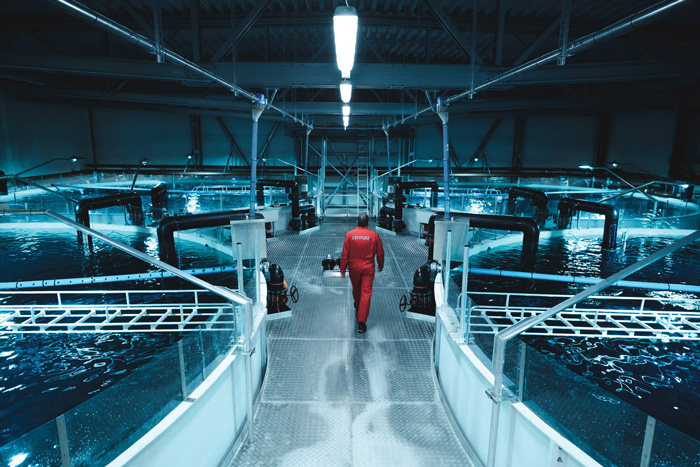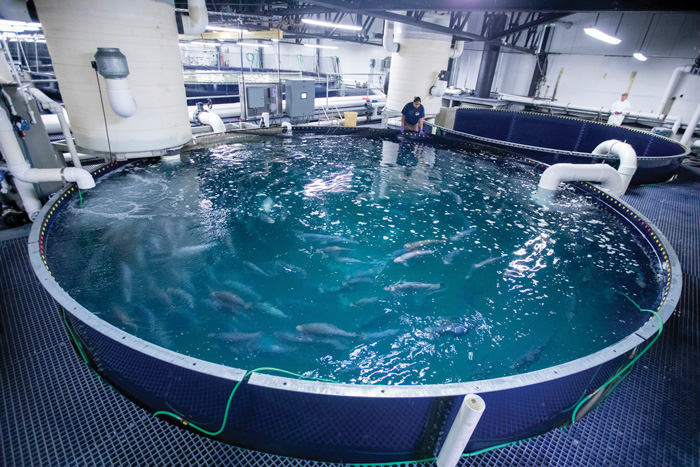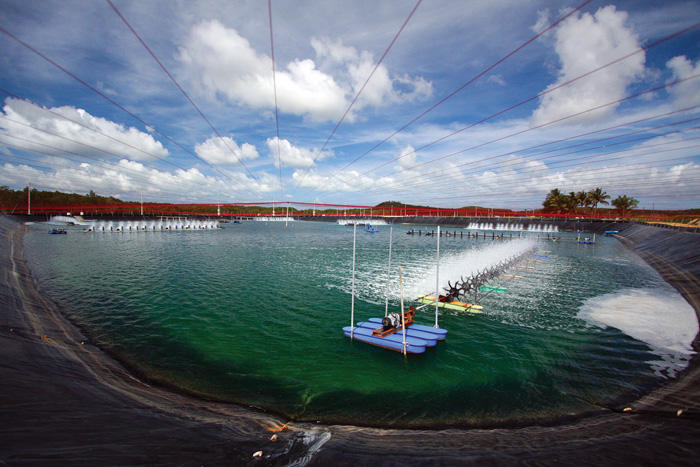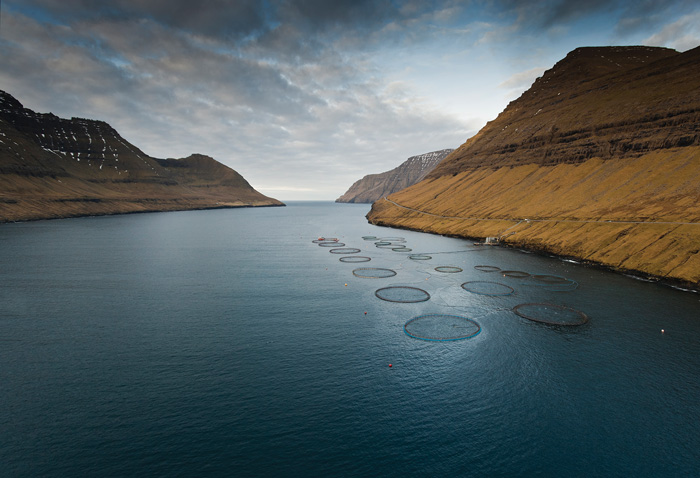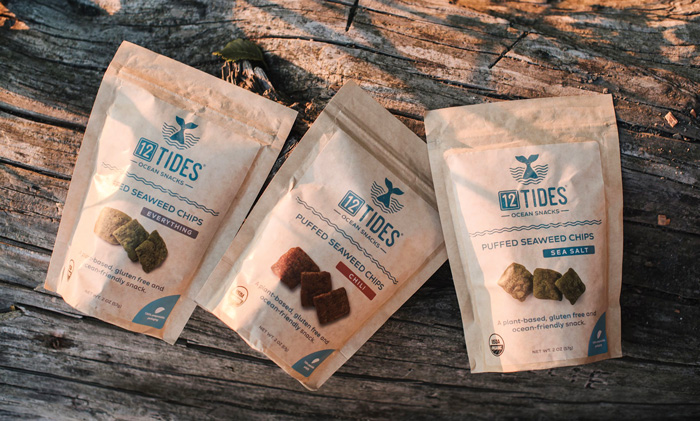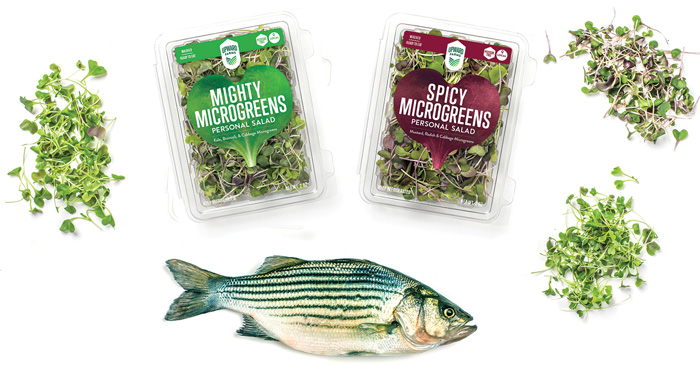
Sea Change: New Horizons in Aquaculture
Sophisticated technologies coupled with environmental advantages are making aquaculture an increasingly viable approach to feeding a global population hungry for seafood.
Article Content
Aquaculture has always been about the potential for spawning a “blue revolution” that would overturn the long-reigning paradigm for global food consumption and allow humankind to extend the bounty of seas, lakes, and rivers in fantastic new ways instead of scratching out subsistence in the soil.
But now, aquaculture is all about the need. As in, we may need aquaculture and aquaponics to produce greater results faster than once imagined.
“There’s a big existential threat from the world’s growing population, and traditional farming and agricultural methodologies won’t be able to scale to meet that need,” says Brian Frank, general partner of FTW Ventures, a San Francisco–based firm that invests in innovative food producers.
“There’s also obviously a huge movement to fix the degradation of the environment. And the third thing is climate change, which will shift how food is produced in the long term,” Frank continues. “We need to spur innovation in aquaculture so that people in another quarter-century have access to the nutrients they need but aren’t degrading the environment.”
While raising fish, crustaceans, and mollusks in landlocked ponds and fenced-in ocean pens has gone on for decades, the full potential of the industry has kept receding into the horizon. Oceans and waterways cover about 70% of the planet, but still only about 5% of food production comes from the water. Now, leaders in aquaculture are stepping up to the strong possibility that their industry’s time finally has come.
“There’s less fish coming out of the sea, and catch quotas are being reduced, but people are still wanting to buy fish,” says Jamie Stein, co-founder of United Kingdom–based Devonian Capital, which is investing exclusively in aquaculture startups. “Add consumer preferences for sustainably produced seafood, and the environmental impact, and you’ve got a strong marketing story as well as a strong economic story.”
Already, aquaculture has picked up the slack as worldwide fishery outputs have stagnated due to the scourge of overfishing, restrictions by some governments, and reductions in seafood populations presumably wrought by climate change. As aquaculture has advanced technologically, scaled up, and become more economical, net- and farm-raised seafood have supplied an increase in global per capita fish consumption even with a rising population. Aquaculture now produces about half of all seafood.
In fact, while a relatively insignificant contributor just a generation ago, aquaculture in 2015 surpassed wild fisheries as a source of seafood for human consumption. The annual biomass produced by aquaculture now also exceeds that of beef, and its growth rate has outstripped that of poultry production, making it the fastest-growing agricultural sector. With increasing evidence that seafood is an environmentally sustainable method for protein production, aquaculture is likely to keep gaining on terrestrial protein rivals such as poultry.
The aquaculture industry in 2018 reached an estimated $232 billion in revenue, for 80 million metric tons of food, according to the United Nations’ Food and Agriculture Organization (FAO), with dozens of species raised in marine, freshwater, and brackish environments. The take is expected to reach $275 billion by 2025, according to Adroit Market Research. The demand will be “driven by the rising consumption demand for seafood coupled with the exhaustion of the ocean’s natural fish productivity [by] uncontrolled exploitation of wild fish over several decades,” according to Adroit.
Asia Leads the Way
Asia has dominated aquacultural production: Fully 89% of the output of aquaculture, by quantity, originated in Asia in 2016, and about 62% took place in China, according to the FAO. Mostly that’s because the region had an early start and because policymakers in the three largest aquaculture producers—China, Indonesia, and India—have had to feed large populations. Some western countries, most notably Norway and Canada, also have emerged as aquaculture leaders via strong research funding and friendly policymaking. But the United States has remained a laggard so far.
That most aquaculture occurs in Asia helps account for the fact that various types of carp comprise four of the top 10 aquaculture species globally. Tilapia and shrimp have become truly global aquaculture species as well. About 25% of the industry consists of mollusks such as cupped oysters and Japanese carpet shell clams.
Much of today’s action in aquaculture is in salmon, whose popularity as an aquacultural species has been rising because of the fish’s high nutritional content and increasing popularity with Western consumers. Also, the salmon-raising industry has been the leader in mechanizing aquaculture and bringing modern technology to the practice.
Recirculating Aquatic Systems (RAS) have been the key to revolutionizing salmon raising, providing new technology for oxygenation, biofiltering of wastes, and the other requirements for raising Atlantic salmon in fresh water to the juvenile stage, after which they’re shipped to ocean-based pens.
One key is that RAS farms can be put just about anywhere. There has been an explosion of new projects over the past several years, including Superior Fresh, currently the largest producer, in Hixton, Wis. Another ambitious initiative is Atlantic Sapphire, a $350 million facility being built in Miami, where its Danish founders envision providing half of America’s salmon by 2030.
When COVID-19 hit, it created even more of a fever behind RAS investments. “Rich guys who normally would invest in other industries now were sitting at home and couldn’t get a piece of salmon,” as Terence Barry, an emeritus scientist in aquaculture at the University of Wisconsin–Madison, puts it. “So they realized how much we depend on foreign fish and that we needed to invest in U.S. aquaculture instead of getting their fish shipped from Norway.”
But there are problems with raising salmon. For one thing, it takes a lot to feed them. “That’s one of the main challenges,” says Sophie Ryan, CEO of the Global Salmon Initiative, a consortium of 13 of the largest farmed-salmon producers around the world. “It takes sources of fish out of the ocean, which could stay in the ocean or be used elsewhere. It also impacts biodiversity.”
The ratio of fish required to feed salmon previously was three-to-one. But in large part due to efforts by the Initiative, that ratio now has come down to about one-to-one. Alternative feed sources including algae, canola, and insects have gained share even as salmon production continues to grow.
Certification is one of the industry’s weapons. Seven years ago, there were no universal standards for raising salmon. But now, after the creation of the Aquaculture Stewardship Council, about 60% of global salmon farms are certified and monitored for continuously improving performance in use of antibiotics and farm management.
New Options From Startups
Another dynamic created by the challenges to Atlantic salmon farming is that more startups are offering species alternatives. Thus, one company in which Devonian has invested is Finger Lakes Fish, better known as LocalCoho, which is growing coho salmon in upstate New York.
Finger Lakes Fish has built a 43,000-square-foot RAS facility in Auburn, N.Y., and plans full capacity for putting out 2,000 fish a week, at an annual run rate of 450 tons. Its two “raceways”—tanks of oxygenated water where salmon live—are six feet deep, 16 feet wide, and 80 feet long. The sushi-grade coho salmon are hatched from certified organic eggs and raised to maturity.
Finger Lakes raises its coho salmon without antibiotics or pesticides or contaminants in the water and keeps them in the tanks through adulthood. “It’s a completely closed environment with no possibility of diseases or systemic problems,” says Phil Gibson, CEO of Finger Lakes. “But it’s a different species, so it’s not in direct conflict with Atlantic salmon. Plus, it’s at a price premium because RAS technology is more expensive than raising fish in the ocean.”
Another alternative to Atlantic salmon is steelhead trout, a salmonid that is flopping around in an RAS system of 54 tanks and 3.5 million gallons of water in a 160,000-square-foot building at Hudson Valley Fisheries in Hudson, N.Y. They grow from egg to harvest size in about 16 months, and the company is aiming to peak out at shipping more than 2.2 million pounds of trout each year to restaurants and retail distributors on the U.S. East Coast.
COVID-19 wrecked the company’s substantial restaurant business for now, but Hudson Valley quickly pivoted to e-commerce and local farmers markets to supplement a retail store trade that survived the pandemic. The company also began playing up the advantages of a closed system.
“When we’re challenged on that, when people think wild-caught is a healthier product, we help people understand that wild fish carry pollutants such as heavy metals and microplastics,” says Hudson Valley Chief Executive Officer John Ng.
Another company proffering an alternative to farmed salmon is Australis, which raises barramundi. It starts in land-based ponds; then the juvenile fish are transferred to ocean nets in Vietnam. Barramundi is a mild whitefish, but Australis Founder Josh Goldman calls the species “in effect, a tropical salmon,” and he says barramundi is the fastest-growing aquacultural species globally.
Shrimp is another major aquaculture category grown in ponds. For example, Chicken of the Sea, owned by Thai Union North America, farms white-legged shrimp in saltwater ponds located close to oceans in countries throughout Asia and Latin America, and freezes them. “We’re the largest single importer of farmed shrimp,” says Roxanne Nanninga, director of sustainability for the El Segundo, Calif.–based company.
Ponds were the main sites for aquaculture as the industry took off in the 1970s, in part backed by mighty institutions such as the Rockefeller Foundation. Aquaculturists began to transfer knowledge from agriculture to “farming” in water. “You began to see aerators that allowed you to control oxygen levels in ponds and enabled you to keep big numbers of aquatic organisms alive for longer periods of time, so you could create a farm,” says Frank Asche, a professor in fisheries and aquatic sciences at the University of Florida.
In addition to RAS, a relatively new technology known as biofloc has continued to improve pond environments. Biofloc enhances water quality by balancing carbon and nitrogen in the pond system, with the added value of producing proteinaceous feed in situ.
Over the last few decades, open-net fencing of areas of oceans also became popular for fish farming. “Our ability to fence in water was very limited until recently, because it’s hard to do,” Asche says. “Yet it’s growing because digging a pond is very expensive, and it becomes much more expensive to do than fencing. It’s also hard to see what’s going on in that body of water.”
In both ponds and the ocean, “As soon as you had the ability to create these farms, and control over creatures, you could start using the whole knowledge system from agri-science, including breeding, feeding, and disease management,” Asche says. “In a sense, the holy grail was to become as sophisticated as the modern chicken barn.”
Feeding Farmed Fish
Just like with the modern chicken barn, the biggest challenge to aquaculture in any setting is optimizing inputs and outputs. For one thing, aquaculturists are facing limits on availability of fish meal made out of small varieties such as anchovies, which traditionally have been the biggest source of nutrients for large species such as salmon and tuna, mimicking nature.
“Fisheries for anchovies have become stagnated because governments have put capacity limits on them,” says John Bowzer, senior research scientist for Archer Daniels Midland (ADM). “That has to be replaced with other quality ingredients that fit into the diets of the target species.”
Right now, 70% of the world’s fish oil supplies go back into aquaculture. But limits on aquatic sources have meant modern aquaculture largely depends on terrestrial feed crops and increasingly competes for resources with livestock, the energy industry, and direct human consumption. That pinch has led to fast-rising interest in innovative sources of supply, including bacteria-based proteins, insect meal, and oil from microalgae.
That’s where Chicago-based ADM comes in, fermenting algae in large tanks like those used in microbrew and ethanol production, and providing algal oil for aquaculture feed. Another oil provider is Netherlands-based Corbion, which says its algal variety contains three times the level of DHA found in fish oil.
“We’re recreating some of the same nutrient profiles as wild fish that salmon normally would eat in the wild, and a replacement for the fish oil and fish meal derived from fish that salmon eat in aquaculture,” says Jill Kauffman Johnson, head of global market development for algae ingredients for Corbion. “It’s a more sustainable feed scenario.”
At the same time, no matter how the fish are fed, salmon farming’s effects on the ocean environment can be significant, and that has prompted national governments to boost regulatory control. “In the early days of that industry, the feed that wasn’t eaten by fish went to the bottom, and the fish below them were eating feces of salmon and sea bass,” Asche explains.
But Asche says the hurdle for salmon farms now “is a lot like the challenges in farming, where most developed countries are limiting the number of pigs or cows a farmer can have and how much manure they can get rid of. Can an ocean pen make an environmental impact so moderate that they don’t have any system-changing impacts? Yes, as long as you situate them in areas where you’re not overloading the system.”
Now, says Stein, “As you produce salmon in Norway or Chile or the United Kingdom, you’re not allowed to just keep throwing more and more net pens into the sea. There are restrictions on the volume of salmon in licensed areas because of the pollution that comes from these farms.”
Indeed, Ryan argues that the salmon industry, at least, “has evolved and learned” how to control that problem so that it can “have the lowest impact possible.”
Arguments like these over environmental sustainability are shaping much of the future of aquaculture in the United States and elsewhere. To be sure, one lens views it as an important alternative to land-based agriculture, which is being stressed by global population growth, restricted by rising concerns about climate change, and limited practically by pressing more marginal lands into service.
“If you can come up with sufficient product and technologies that can grow food in the world’s waters, you can relieve pressure on land and for deforestation,” Asche says. On the other hand, there are opposing views, by people who view harnessing the waters for anything as adding environmental stress. “They view aquaculture as a new way of infringing on the system,” he says. “But overall, it looks like you’re doing the environment a favor if you are eating a chunk of salmon instead of a steak or a pork chop.”
Meanwhile, aquaculture also is having to adjust to how global waters may be affected by climate change. “As oceans get warmer, spawning grounds will be more deteriorated or will have to shift,” Frank says. Aquaculturists “won’t be able to produce or harvest in the same way.”
Such environmental pressures, as well as economic incentives, are generating more innovations in aquaculture. Rising water temperatures and changes in ocean acidity are prompting more aquaculturists to raise species such as blue mussels, which can alter patterns in their genes to become resistant to environmental changes. Sea urchins, popular in Japan and other countries, are another type of aqua-farmed species resistant to climate vagaries.
Companies and governments are researching new opportunities for aquaculture that can cut costs and reduce environmental loads. For example, wanting to reduce the need for wild harvesting of some of the most popular varieties of fish, Japanese scientists are transplanting stem cells from bluefin tuna into smaller, related species that can be raised more quickly via aquaculture and cut the demand for wild-harvested bluefin.
“They’ve been focusing on species that sexually mature more quickly and have been cultured before, such as mackerel and yellowfin tuna, and can be grown in outdoor pens,” says Tawny Scanlan, an FTW Ventures associate who is affiliated with the vaunted aquaculture program at the University of California, Davis. “Yellowfin mature in just five to six years versus 10 to 12 years for bluefin.”
Serving Up Seaweed
There’s also more emphasis on increasing aquaculture of kelp and other sea plants, which—just like plants on land—are considered more environmentally friendly than creatures. Seaweed is low in fat and rich in proteins, carbohydrates, minerals, vitamins, and essential micronutrients. It also captures and stores carbon dioxide, the scourge of climate stress.
That’s why a coalition of groups, led by the Lloyd’s Register Foundation, this year issued Seaweed Revolution, a “manifesto” proposing a vision for a greatly expanded seaweed industry playing a globally significant role in food security, climate change mitigation, “and support to the marine ecosystem” as well as contributing to job creation and poverty alleviation.
At this point, nearly all seaweed is cultivated in Asian coastal waters. But some entrepreneurs are trying to expand seaweed aquaculture by approaching it from the demand end. Western consumers mostly have shunned seaweed except in sushi and some dried snacks, and that’s mostly from Asian seaweed varieties called nori. So Patrick Schnettler started a company in San Francisco called 12 Tides that produces organic puffed snacks in flavors such as sea salt and chili, made from kelp seaweeds that are cultivated in North America.
“Kelp absorbs carbon at a pretty extraordinary rate and can grow super fast, more than a foot a day during growing season,” Schnettler says. “At least at a local level, this model also can mitigate some of the impacts of acidification from climate change, which has implications for biodiversity.”
Another new frontier is “cultured” seafood, which some in the industry call “cellular aquaculture,” though it goes to the extreme of negating the need for aquaculture as well as wild harvesting. San Diego–based BlueNalu, for example, starts with tissue from popular fish such as yellowtail and mahi and teases them into pieces of fish analog with the aim of replicating the nutrition and sensory experience of real seafood.
It’s way too early to tell whether such engineered foods ever will complement wild-caught and aquaculturally raised seafood to any significant degree. “I’ve seen surveys that suggest maybe one or two out of three people will try cultured seafoods, but will they make it part of their diet?” Frank says. “Within two or three years, it’ll show up in high-end restaurants that want to take a gamble and show them off. But the next stage is mass production, and I’m not sure that’s viable.”
In the meantime, it’ll be up to aquaculture to keep trying to close the gap between current demand for seafood and the anticipated needs of the future. “We need to improve awareness that in terms of health, there is no difference between wild and farmed salmon. And there is no difference in the environment, either,” Ryan says. “If you can find good wild-caught, that’s great. But if you can’t, aquaculture is a good alternative as well.”
The further growth of aquaculture also increasingly will include the challenge of confronting the suspicions of many consumers about farmed versus wild-caught fish—especially in an era when the production narratives behind all foods have become so important to so many. The environmental benefits of farmed versus caught seafood could help in that regard.
“The aquaculture space right now is really about sustainability,” says ADM’s Bowzer. “And a lot of that is driven by the customer base.”


